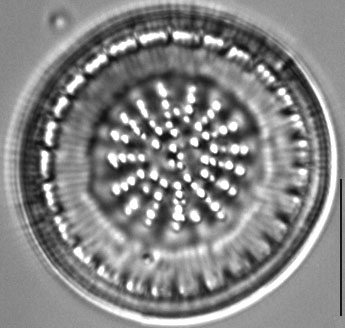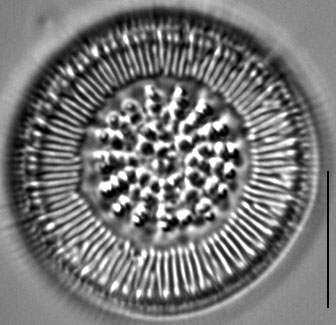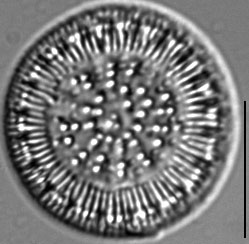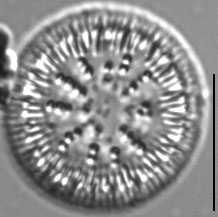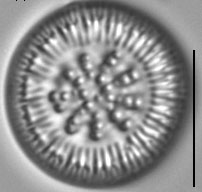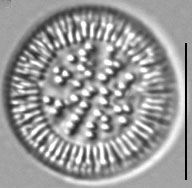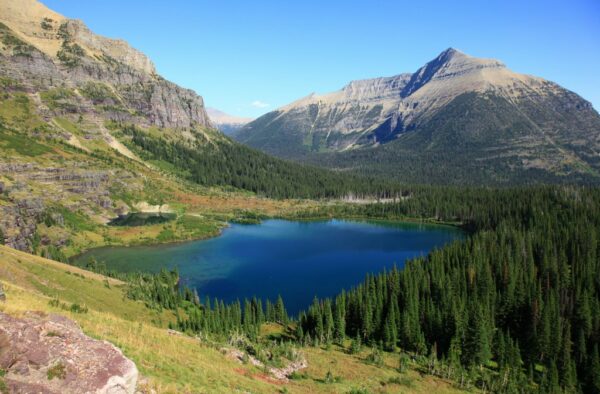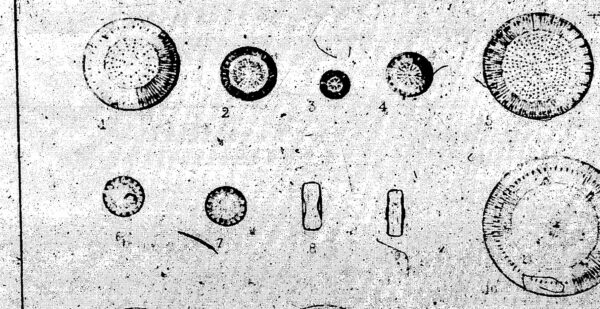Lindavia radiosa
-
Category
-
Diameter10.9-23.8 µm
-
Striae in 10 µm14-18
-
SynonymsCyclotella radiosa (Grunow in Van Heurck) Lemmerm.
-
Reported AsPuncticulata radiosa (Tanaka 2007, p. 45, plates 60-63)
-
ContributorLoren Bahls - Dec 2013
-
ReviewerKalina Manoylov - Dec 2013
Identification
Description
Cells are cylindrical with shallow mantles. The valve face is concentrically undulate, with a marginal ring of striae that occupy slightly more than one-half of the valve radius. At the center of the valve, coarse areolae of equal size are arranged in a radiate pattern. One to several areolae are scattered in the clear area at the center of the valve. The marginal striae are slightly unequal in length. Every fourth or fifth interstria, also called a costa, is thickened. These thickened costae appear in LM as shadow lines, or Schattenlinien, which number about 4 in 10 µm.
Håkansson (2002), Houk et al. (2010) and Tanaka (2007) published SEM images and written observations of this taxon, although they are not of North American specimens. External views show a concentrically undulate and radially wrinkled valve face. The slightly convex central area is surrounded by a shallow depression. Radial lines of areolae and central fultoportulae lie in grooves separated by low ridges, on which small granulae are scattered or also arranged in radial lines. At least one rimoportula opens to the outside at the end of a shortened stria. The striated marginal area consists of multiseriate striae that continue onto the mantle. Areolae in the striae are much finer than those in the central area. A ring of marginal fultoportulae occurs at the junction of the valve face and mantle.
Internally, striae are expressed as short, oblong alveoli separated by costae. The costae are sometimes divided, with every fourth or fifth costa is thickened and bearing a marginal fultoportula. The marginal fultoportula consists of a short tube with two lateral satellite pores. At least one rimoportula with is located between the central area and the marginal alveoli. The central area is concentrically undulate with areolae and several central fultoportulae arranged in radial rows. Each central areola is covered with a domed cribrum. Central fultoportulae consist of a short tube surrounded by three satellite pores.
Autecology
Lindavia radiosa is a planktonic diatom of the pelagic zone of oligotrophic to mesotrophic alpine and subalpine lakes. It was described from Lake Mondsee in Austria and has since been reported from several lakes in Germany and from a lake in the High Tetras of Slovakia (Houk et al. 2010). Tanaka (2007) reported C. radiosa as living in Lake Biwa, Japan, and from fossil deposits in Japan. The specimens shown here were collected from two high elevation lakes in Glacier National Park, Montana (Ellis et al. 2002). Beaver Woman Lake (elev. 1789 m) has a pH of 7.77, a conductivity of 83 µS/cm, total phosphorus of 4.1 µg/L, and total nitrogen of 67 µg/L; Stoney Indian Lake (elev. 1928 m) has a pH of 7.96, a conductivity of 126 µS/cm, total phosphorus of 5.9 µg/L, and total nitrogen of 65 µg/L. Values for other chemical variables are provided by Ellis et al. (2002).
-
Size Range, µm3
-
Motility
-
Attachment
-
Habitat
-
Colony
-
Waterbody
-
Distribution
- Learn more about this
Citations & Links
Citations
-
Publication Link: 10.1080/0269249X.2002.9705534
-
Publication Link: 10.11646/phytotaxa.217.3.2
Links
-
Index Nominum Algarum
-
GenBank
Updates
Apr 25, 2024 - Transfer from Cyclotella radiosa
Transferred on this website from C. radiosa to L. radiosa, following Nakov et al. (2015). - S. Spaulding
Cite This Page
Bahls, L. (2013). Lindavia radiosa. In Diatoms of North America. Retrieved April 25, 2024, from https://diatoms.org/species/lindavia_radiosa
Responses
The 15 response plots show an environmental variable (x axis) against the relative abundance (y axis) of Lindavia radiosa from all the stream reaches where it was present. Note that the relative abundance scale is the same on each plot. Explanation of each environmental variable and units are as follows:
ELEVATION = stream reach elevation (meters)
STRAHLER = distribution plot of the Strahler Stream Order
SLOPE = stream reach gradient (degrees)
W1_HALL = an index that is a measure of streamside (riparian) human activity that ranges from 0 - 10, with a value of 0 indicating of minimal disturbance to a value of 10 indicating severe disturbance.
PHSTVL = pH measured in a sealed syringe sample (pH units)
log_COND = log concentration of specific conductivity (µS/cm)
log_PTL = log concentration of total phosphorus (µg/L)
log_NO3 = log concentration of nitrate (µeq/L)
log_DOC = log concentration of dissolved organic carbon (mg/L)
log_SIO2 = log concentration of silicon (mg/L)
log_NA = log concentration of sodium (µeq/L)
log_HCO3 = log concentration of the bicarbonate ion (µeq/L)
EMBED = percent of the stream substrate that is embedded by sand and fine sediment
log_TURBIDITY = log of turbidity, a measure of cloudiness of water, in nephelometric turbidity units (NTU).
DISTOT = an index of total human disturbance in the watershed that ranges from 1 - 100, with a value of 0 indicating of minimal disturbance to a value of 100 indicating severe disturbance.

Lindavia radiosa
- Central areolae in radial rows
- Central areolae coarse
- Marginal striae occupy about half valve radius
- Marginal striae with shadow lines
Valves are concentrically undulate and radially wrinkled. The central areolae are coarse, equal in size and arranged in radial rows. Marginal striae have shadow lines and occupy about half of the valve radius.
 Diatoms of North America
Diatoms of North America